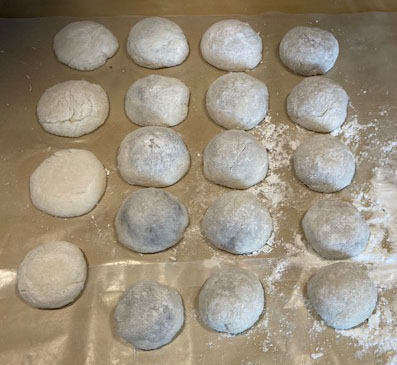Happy New Year!
I hope everyone’s had a good time ringing in the new year! Here in the Bay Area things were rather muted with everyone trying to hide from omicron.
I’ve managed to make it to see another year, and to hopefully see a few more it’s time to make mochi!
Mochitsuki

Mochitsuki is the Japanese tradition of making mochi for the New Year. It brings health and good luck, both of which I wouldn’t mind in the months ahead 😃. It’s also said to promote strong teeth (particularly kagami mochi, which is rock hard after having sat out on an alter for while.) That doesn’t seem to have worked so well with me. I was such a great repeat patient that my endodondist was able to retire last year.
I’ve been making mochi on New Year’s Day for the past several years. Except for 2020. And look what happened then… So I’ve been advised to not skip any more years.
Mochi is traditionally made by soaking mochi-gome (sweet rice) overnight, steaming it, and then pounding the steamed rice in an usu (mortar) with a kine (mallet). Growing up in Hawaii I remember one year when mochi was made this way at the Minakami extended family New Years Day gathering. I also remember that in following years a mochi machine was used to prepare the mochi 😃. Here’s a video showing the pounding process. It makes you wonder if the Japanese ER rooms are filled with people with mashed hands around New Years.

Since it’s just me making the mochi (and even if I had some friends helping I don’t want my hands to turn into pancakes), I take some liberties in the process. I use a rice cooker to steam the mochi-gome, then put the steamed rice in a mixing bowl and use a pestle to pound it. It takes about fifteen or twenty minutes to pound the rice, and your arms get a good workout in the process 😃.
One you have a large, sticky mass of paste it’s time to make the individual mochi. I’m still trying to figure this part out. One thing I’ve learned is to make good use of potato starch to keep the paste from sticking to everything. Coat the surface you’re working on and your hands liberally!

Traditionally New Year’s mochi are just plain discs, but I usually make a number with fillings – this year it’s azuki an (red bean paste), chocolate, and peanut butter. JT is on a restricted diet with no dairy, gluten, or soy and as luck would have it all the mochi met these criteria (which is a good thing since I need my friends to help eat the mochi – it needs to be consumed in a couple days or it’ll start getting moldy. These aren’t the mochi you find in stores with preservatives to keep them fresh for a while!)
Trying to form the plain mochi discs is something I haven’t quite mastered. Inevitably they have a lot of creases and folds. Making the filled mochi is counterintuitively a little easier. You make a small pancake and put it in the cupped palm of your hand. Then place the filling in and wrap the pancake around it. Pinch the edges to seal. Here’s a good video from Just One Cookbook. Nami-san makes it look so easy!

While the mochi with filling is eaten as-is, for New Years the plain mochi is often eaten in ozoni (New Year’s soup) or zenzai. Other ways of preparing plain mochi are kinako mochi (roast/fry the mochi then coat with a soy flour and sugar mixture – my favorite), or isobeyaki (roast/fry the mochi with shoyu and sugar). Here are some instructions from Just One Cookbook.

Mochi is my wife’s and daughter’s favorite. They like Taiwanese mochi though. Taiwanese mochi is the plain mochi without any filling and is smaller. We usually dip it with peanut powder and sugar.
In Taiwan, Japanese mochi is called Daifuku, 大福 in Chinese, meaning “Great Fortune”!